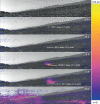The sound of a Martian dust devil
- PMID: 36513637
- PMCID: PMC9747922
- DOI: 10.1038/s41467-022-35100-z
The sound of a Martian dust devil
Abstract
Dust devils (convective vortices loaded with dust) are common at the surface of Mars, particularly at Jezero crater, the landing site of the Perseverance rover. They are indicators of atmospheric turbulence and are an important lifting mechanism for the Martian dust cycle. Improving our understanding of dust lifting and atmospheric transport is key for accurate simulation of the dust cycle and for the prediction of dust storms, in addition to being important for future space exploration as grain impacts are implicated in the degradation of hardware on the surface of Mars. Here we describe the sound of a Martian dust devil as recorded by the SuperCam instrument on the Perseverance rover. The dust devil encounter was also simultaneously imaged by the Perseverance rover's Navigation Camera and observed by several sensors in the Mars Environmental Dynamics Analyzer instrument. Combining these unique multi-sensorial data with modelling, we show that the dust devil was around 25 m large, at least 118 m tall, and passed directly over the rover travelling at approximately 5 m s-1. Acoustic signals of grain impacts recorded during the vortex encounter provide quantitative information about the number density of particles in the vortex. The sound of a Martian dust devil was inaccessible until SuperCam microphone recordings. This chance dust devil encounter demonstrates the potential of acoustic data for resolving the rapid wind structure of the Martian atmosphere and for directly quantifying wind-blown grain fluxes on Mars.
© 2022. The Author(s).
Conflict of interest statement
The authors declare no competing interests.
Figures





References
-
- Ringrose TJ, Towner MC, Zarnecki JC. Convective vortices on Mars: a reanalysis of Viking Lander 2 meteorological data, sols 1–60. Icarus. 2003;163:78–87. doi: 10.1016/S0019-1035(03)00073-3. - DOI
-
- Murphy JR, Nelli S. Mars Pathfinder convective vortices: frequency of occurrence. Geophys. Res. Lett. 2002;29:18–1-18–4. doi: 10.1029/2002GL015214. - DOI
-
- Greeley R, et al. Active dust devils in Gusev crater, Mars: observations from the Mars Exploration Rover Spirit. J. Geophys. Res. E: Planets. 2006;111:1–16. doi: 10.1029/2006JE002743. - DOI
-
- Ellehøj MD, et al. Convective vortices and dust devils at the Phoenix Mars mission landing site. J. Geophys. Res. 2010;115:E00E16.
-
- Steakley K, Murphy J. A year of convective vortex activity at Gale crater. Icarus. 2016;278:180–193. doi: 10.1016/j.icarus.2016.06.010. - DOI
Publication types
MeSH terms
Substances
LinkOut - more resources
Full Text Sources
Miscellaneous

